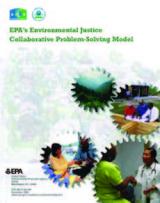Environmental Justice Primer for Ports: Collaborative Problem-Solving
On this page:
- Environmental Justice Collaborative Problem-Collaborative Model
- Consensus Building
- Dispute Resolution
- Community Benefits Agreements
- Tools
Environmental Justice Collaborative Problem-Solving Model
Tips for Building Consensus and Resolving Disputes
- Design processes, both formal and informal, to ensure fair treatment and meaningful participation of all stakeholders.
- Promote the development of a common vision and goals among all partners.
- Use facilitators or mediators to assist in the communication and negotiation process.
- Identify, nurture and promote win/win scenarios and mutual gains.
- Use alternative dispute resolution techniques to resolve crystalized disputes.
The Environmental Justice Collaborative Problem-Solving Model defines collaborative problem-solving as when "various stakeholders agree to work together to address a particular issue or concern... Such collaboration fosters the conditions that enable the parties to mobilize the resources necessary to realize stronger, more lasting solutions."21 The Environmental Justice Collaborative Problem-Solving Model (CPS) includes the following seven elements:
Element 2: Community Capacity-Building and Leadership Development
Element 3: Consensus Building and Dispute Resolution
Element 4: Multi-Stakeholder Partnerships and Leveraging of Resources
Element 5: Constructive Engagement by Relevant Stakeholders
Element 6: Sound Management and Implementation
Element 7: Evaluation, Lessons Learned and Replication of Best Practices
Consensus Building
At the heart of collaborative problem-solving is consensus building. Building consensus means seeking agreement among different and, often times, competing interests by encouraging all participating stakeholders to seek common ground and derive mutual gains. Consensus building requires members to work together to seek creative solutions to meet the needs and interests of each member of the group.
Dispute Resolution
A dispute happens when a conflict between different parties has reached an impasse. Dispute resolution processes can be legally mandated or consensual. Enlisting a neutral third-partyfacilitator or mediator can greatly assist in resolving disputes productively and provide the parties with greater control over the process and outcomes. Disagreements about facts or the interpretation of data may arise in virtually all situations involving disproportionate environmental and/or public health issues. When disagreements about facts or data occur, the stakeholders can jointly choose to use an expert or team of experts to conduct neutral fact-finding.
Community Benefits Agreements
A Community Benefits Agreement (CBA) is an agreement between developers, public and private entities, and community-based organizations to address concerns or harms. CBAs represent community concerns and directly relate to the land use and/or environmental impacts of the proposed development.
Past CBAs have included a range of benefits, including construction of affordable housing, job hiring commitments, living wage jobs, new public facilities and amenities, new or improved transportation infrastructure, environmental remediation, and commitments to sustainable construction practices.
CBAs can play an important role in engaging near-port communities and ports in mutually beneficial partnerships. Employment and job training is a particularly important issue for near-port communities. A port and community entering into a job training and labor agreement that pertains to a new development project proposed by the port is an example of a CBA. Existing conditions assessments can compare the conditions in near-port communities with conditions across the region to assess potential disparities and establish a baseline for improving quality of life.
The key steps in developing effective CBAs include:22
- Conduct a technical assessment of local conditions.
- Identify key stakeholder groups.
- Conduct a needs assessment (derived from interviews with stakeholders).
- Decide CBA legal framework and terms.
- Build community capacities to sustain partnerships and investments:
- Cross-cultural relationships.
- Collaborative problem-solving.
- Targeted technical assistance.
- Monitor outcomes.
Tools
- Environmental Justice Collaborative Problem-Solving (CPS) Model:23 Systematic community-based approach for stakeholders to achieve lasting solutions for local environmental and public health issues and concerns.
- Collaborative Governance (PDF)Exit(29 pp, 203 K, About PDF):24 Public and private stakeholders come together in collective forums with public agencies to engage in consensus-oriented decision-making regarding agency plans and actions.
- The Community Action for a Renewed Environment (CARE) Model: The EPA CARE model provides partnership approaches and methods to empower communities to collaboratively investigate environmental issues and reduce toxic emissions. The CARE Community Resource Guide outlines the CARE model, which is summarized in Table 3.
- Working Effectively with Tribal Governments (PDF) Exit(48 pp, 395 K, About PDF): This tool provides an understanding of the unique status of tribes, their historical relationship with the federal government, and how it affects government programs, responsibilities and initiatives.
- Asset-Based Community Development (ABCD)Exit:25 A strategy for sustainable, community-driven development. Beyond the mobilization of a particular community, ABCD focuses on linking micro-assets to the macro-environment. The appeal of ABCD lies in its premise that communities can drive the development process themselves by identifying and mobilizing existing – but often unrecognized – assets, and thereby respond to and create local economic opportunity.
| Stage in the CARE Process | Part of the Resource Guide |
|---|---|
| The community, in partnership with EPA, creates a collaborative problem-solving stakeholder group representing community stakeholders. | Part I: Getting Started and Building Relationships |
| The stakeholder group assesses the community’s toxic exposure problems. | Part II: Understanding the Risks in Your Community |
| Partnering with EPA, the stakeholder group selects and funds projects designed to reduce risk and improve the environment. | Part III: Methods to Reduce Your Exposure |
| The stakeholder group tracks progress, evaluates programs and develops new ways to bring funds and new partners into the community to fund further risk reduction measures. | Part IV: Tracking Progress and Moving Forward |

